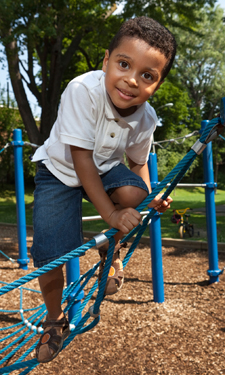 In her travels throughout the country as a playground consultant, Teri Hendy sees nearly every variety and condition of playground. What she sees lately should come as no surprise to cash-strapped agencies: a marked decline in the levels of maintenance of playgrounds.
In her travels throughout the country as a playground consultant, Teri Hendy sees nearly every variety and condition of playground. What she sees lately should come as no surprise to cash-strapped agencies: a marked decline in the levels of maintenance of playgrounds.
“Many agencies have fallen on tough times as budgets continue to be cut,” says Hendy, an instructor for NRPA's Certified Playground Safety Inspector (CPSI) program and a principal for Ohio-based Site Masters Inc. “Municipal park departments as well as school systems have been hit hard, and maintenance dollars seem to be the first to be cut.”
Because the consequences of injuries are so severe, it’s smart for playground operators to review resources for inspecting and correcting deficiencies in equipment and surfacing. Two major organizations that are involved with playground safety are NRPA, through the association's Certified Playground Safety Inspector education and certification program, and an organization of playground manufacturers, the International Play Equipment Manufacturers Association (IPEMA).
Industry’s Role
NRPA's CPSI program, formed in 1991 and formerly known as the National Playground Safety Institute (NPSI), certifies individuals as certified playground safety inspectors. The current program has more than 6,000 CPSIs throughout the United States. IPEMA, formed in the mid-1990s, serves a similarly significant role by providing third-party playground and surfacing product certification.
Hendy, who also has been a member of IPEMA’s advisory board, sees the legal impact of deteriorating playgrounds.
“Unfortunately, I am seeing a rise in injury claims where lack of maintenance or improper maintenance is alleged to be one of the causes of the injury that the child sustained,” Hendy says.
Tom Norquist is senior vice president of product development, sales and marketing for GameTime and is also an IPEMA board member and its former president. Over IPEMA’s 18-year history, Norquist has observed steady progress in the organization’s efforts to improve playground safety.
“It was a voluntary group that met under the auspices of the National School Supply Equipment Association,” Norquist says. “We got together as playground manufacturers once a year, and we talked about issues and things. We never really did anything until we formed IPEMA, a not-for-profit voluntary organization with a mission, values — the whole deal.
“It’s where competitors can come together and work toward the common good for our industry and for society, whether it’s safety or how we can get more people to understand how important play is — not just for the child but as a lifelong lifestyle — or the work we have done over the years about inclusion and accessibility.”
Norquist says IPEMA is involved in several trends that bear out the organization’s mission, particularly in surfacing improvement and elevating the recognition of the importance of signage.
“We’ve observed the continuous improvements in playground surfacing in terms of attenuation [the ability of surfacing to soften the impact of a fall] as measured by ASTM [American Society for Testing and Materials] International 1292,” Norquist says. “Manufacturers of surfaces are investing in different methodologies of manufacturing and installation of surfacing products to obtain better safety in terms of critical fall heights. I’ve noticed that manufacturers, as well as loose-fill providers, have made incredible progress in terms of heights they can achieve for fall attenuation.”
The trends in playground signage are playing an increasingly significant role in promoting playground safety, Norquist says.
“IPEMA has taken a leadership role in providing and sharing information through its website and through its individual members,” Norquist says. “IPEMA has worked on how to properly site appropriate signage as it pertains to the age of the prospective user. Also, this signage is for coaching users to check out the playground before putting their kids in that environment — determining if it’s in the sun and too hot; or not allowing a child to play on a public playground with bicycle or other kinds of helmets on; or not playing on equipment while wearing clothes with drawstrings.”
At NRPA’s Congress and Exposition in Houston, Texas, this fall, IPEMA plans to release informational materials to help its members, their customers and users about the installation and maintenance of the various surfacing materials that IPEMA certifies for safety.
“So, when they are making decisions about safety and accessibility from a surfacing point of view, they can look at these materials and really understand what is necessary in terms of installation and maintenance for all the different types of materials that are safe for different requirements to fit their community’s needs and budget,” Norquist explains.
Community Help
In her work, Hendy recognizes the effects of strained budgets but sees ways around the problem.
“When I teach the CPSI course, I often tell the attendees that the maintenance staff are the ‘lifeguards’ of the playground,” she says.
“With proper training, volunteers from the community are quite capable of performing routine maintenance on playgrounds,” Hendy continues. “Senior citizens are the fastest-growing population, and many are retired and looking for ways to be involved with their community.”
Hendy would be the first to agree that the alternative to such approaches is grim. “I firmly believe that if you can’t afford to maintain your playground, then you should not have one,” she says. “Proper and timely maintenance is that important.”
Learn more about NRPA's Certified Playground Safety Inspector program.
Phil Hayward is a Virginia-based writer and editor and former editor of Parks & Recreation.

